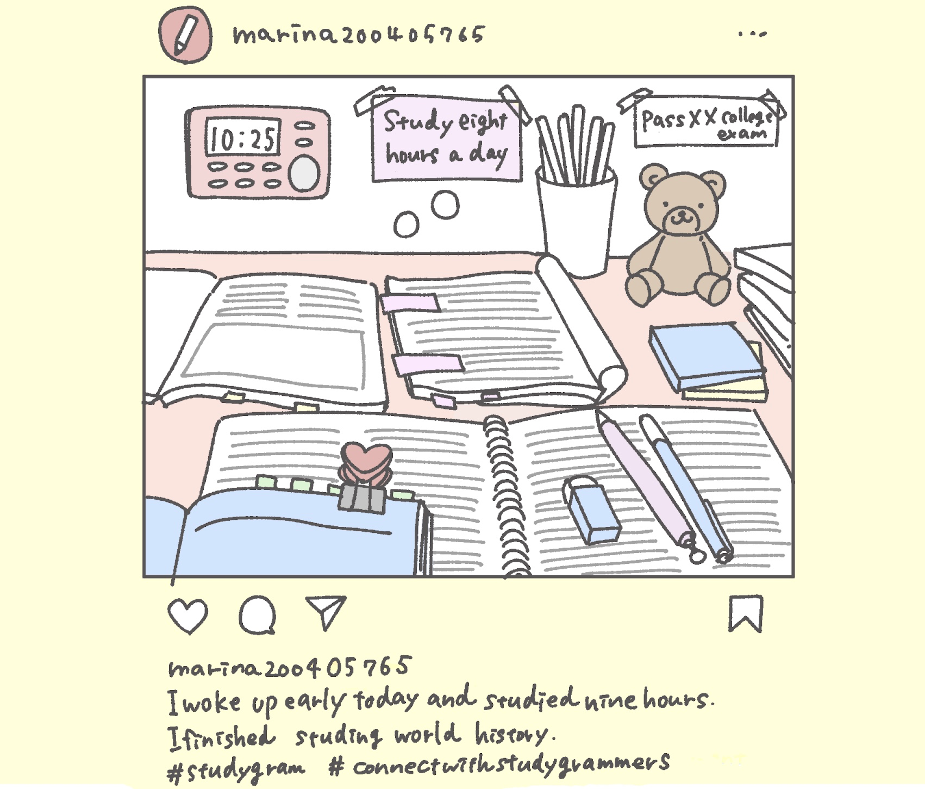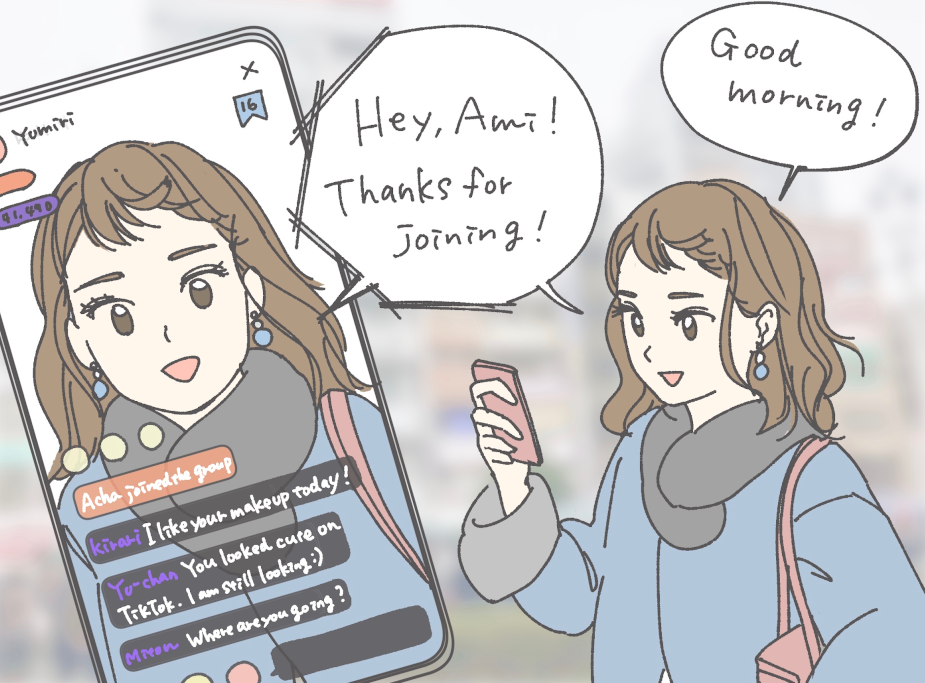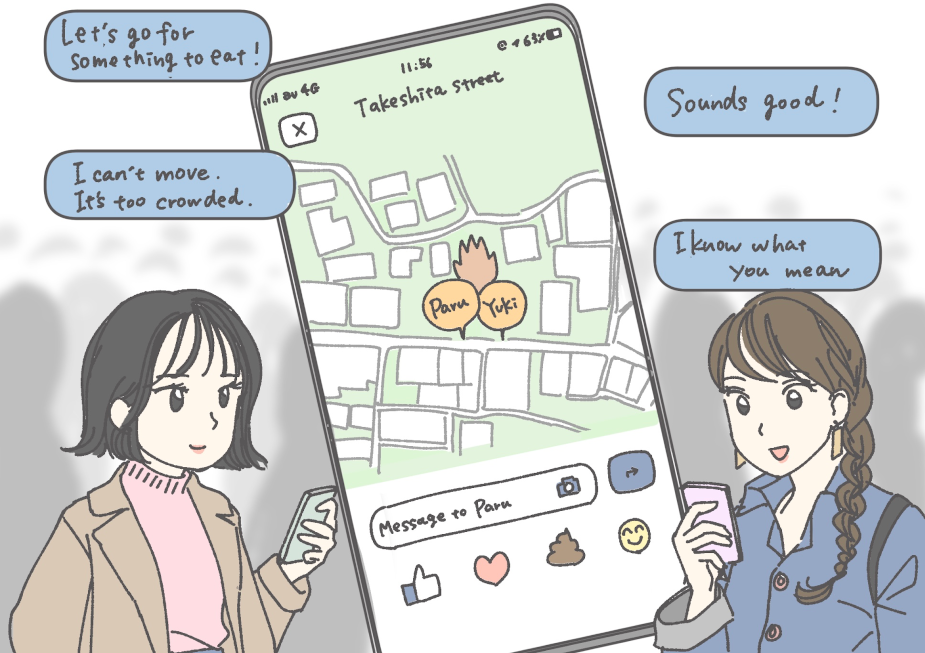
Sharing Homework and Locations - Teenage Girls Always Connect with Others

Dentsu’s research project team, GAL LABO has been exploring new ways of communicating effectively with young women by reducing gaps in awareness between girls and adults. In this article, the team has been focusing on how teenage girls use their time differently than before. One change, in particular, is how private time, which we would naturally assume to mean spending time and doing things alone, has become shared time through the use of smart phones and social media.
In this article, GAL LABO look at how teenage girls spend their private time in diverse ways that would probably surprise many adults. The findings are based on the team’s analysis of interviews with six teenage girls.
Sharing individual study time via social media
With the exception of time spent at school or in cram school lessons, studying is commonly regarded as an activity people do on their own. Many people can remember studying for tests as students, sitting alone at a desk with textbooks and test question sheets while doing their best to concentrate. Since 2016, however, a new trend has appeared on social networking services: students have been creating ‘study accounts’ and sharing information about their study time with others.
This trend originated in South Korea, a country that gives great importance to school entrance exams, and has spread among teenagers all around the world. On Instagram, the English hashtag, #studygram, receives around 5.9 million hits, while the equivalent hashtag (#勉強垢) in Japanese (written in kanji characters and pronounced benkyō-aka) brings up about 1.4 million hits. The posts on these accounts are very diverse. For example, we found a time-lapse video of a student studying at a desk surrounded by cutely designed stationary, and photographs of a timer showing an accumulated number of study hours. We also found an account that specialises in giving advice on keeping notebooks well organised and memorising Japanese historical events and numerical formulas.

A typical studygram post on social media (illustrated by Haruka Watanabe, Dentsu)
In light of this trend, the teenage girls were asked about how they use their study accounts and for what reasons in the interviews.
Staying motivated to study and avoiding loneliness
“I’ve seen all kinds of people posting about studying on TikTok and Instagram, and I follow some that have hashtags like #studygram and #connect with studygrammers. That makes me more motived to study on my own.”
“When I’m feeling down about studying or something, I want to get a boost from others. I really hate feeling secluded. For that reason, I check social media for messages that inspire me and remind me that I’m not alone.”
Interview responses like these indicate how teenage girls use studygrams to stay motivated.
Learning how various people organise their notebooks and solve problems
“I have seen good examples of how other students keep really well organised notebooks.”
“If I make a mistake after trying to solve a problem in my own way, I don’t have any way to get the right answer, so I see how other students handled the problem and take whatever advice is useful.”
A few years ago, students would often copy the notebooks of classmates who received good grades. Today, however, these girls have many more choices for checking how students in Japan and other countries organise their notebooks and solve problems. From among those choices, they can find methods that suit them personally.
A powerful app for quickly solving homework problems
During an interview, one of the girls talked about finding solutions to math problems using an app called Qanda. Originally developed in South Korea as a homework app, Qanda uses AI to give explanations to math problems that students don’t understand, allowing them to learn without a teacher—only a smartphone is needed. The app is not designed for cheating by simply giving correct answers; instead, it explains how to solve the problems, thereby teaching students what they don’t understand when a classroom or cram school teacher is unavailable. By using it, the school girls no not need to worry when studying on their own.
In the interviews, most of the school girls responded that their grades improved after they started using studygrams. Students always seem to be checking their smartphones nowadays, but these students are turning the time they spend using their smart phones into opportunities for studying. To adults, it may appear as if the girls are just wasting time glued to their smart phones, but they are actually studying together with others. In the past, students usually studied with friends at a library, but today, by connecting via social media, students can study with their friends—even from other parts of the world—without meeting face to face.
There are several motives underlying this trend. One is a desire to overcome the demotivating and lonely aspects of studying alone by getting inspired and motivated through others. The school girls also have a desire to find the best personal
alternatives for themselves. Furthermore, they are conscious of their time, so they want to use their time really efficiently without wasting any of it.

Sharing sleeping time and location information
In addition to sharing studying time, an unusual trend has emerged in which people share information about the time they go to bed.
Bedtime chatting
In Japan, some users of radio streaming apps enjoy using the comment function to chat with others until going to bed. Sometimes they actually fall asleep while the radio program is being streamed. The listeners sleep at the same time while listening to the sound of breathing streamed by the app.
In the interviews, the school girls who regularly view video streaming apps like MixChannel and SHOWROOM explained how they use their apps in interesting ways.
Video chatting when walking or in the washroom
“I use a live streaming app to talk with followers when walking to the train station from home, or when doing skincare in the bathroom.”
When asked why she wanted to video chat with somebody when during such times alone, this girl answered that she released stress by chatting about her worries or things that happened that day with “fans” who don’t know her personally. She said that she was able to talk about anything with her fans rather than with her friends.
In addition to chatting with their real friends and family members, chatting with fans is a third setting for sharing time while relaxing.

Sharing locations when alone
The teenage girls who were surveyed also share their location data when alone. In Japan, many senior high school girls use a real-time location sharing app called Zenly. With Zenly, users can share their current location information with close friends, allowing them to check whether their friends are at home or outside. Users can also see how long their friends have been at a place, and how quickly it would take to walk there from the current time.
How do teenage girls use this app and for what purpose?
Meeting friends without prior plans
“If I see that a friend happens to be in the neighbourhood by checking Zenly, I will ask her to go for dinner.”
“I don’t cancel on my friends at the last minute as much as before because we didn’t promise to meet in the first place.”
The girls who were interviewed do not seem to make any plans to meet. When mobile phones came on the market, people became less worried about the chance of not meeting each other, so agreeing on specific times and places to meet lost importance.
Surprisingly, however, teenage girls now make no plans to meet at all; instead they spontaneously decide who to hang out with after checking to see which friends are located nearby.
Finding out about relationships
“It’s fun to check Zenly because now I can find out things like which guy is together with which girl.”
Through social media, users could speculate whether two people were together by checking to see if a guy appeared in posted photos, guessing when posts were made, and so on. With Zenly, however, users can simply check the actual location data.
Concomitant with the trend of sharing one’s location when alone, teenagers find it bothersome to make plans to meet, and they decide who to meet more casually and based on their mood at the time. Accordingly, making their locations public seems to come from a desire for efficiency. While the app may be used only among close friends, and although one’s personal connections are clearly on display and one can even be spied on, a user can check a friend’s locations without purposely asking where he or she is.
Teenagers seem to place high priority on the app’s usefulness for avoiding lost opportunities, such as missing a chance to meet because one didn’t know that a friend was nearby.

Sharing information about one’s private time comes with some problems. When using a location app, one’s location is displayed during times alone, and one’s daily movements can be tracked. Normally that would lead to some anxiety and fear, but users of such apps tend to put that out of their mind. I assume that most people who do not use such a service would feel some discomfort if their location and movements were on display to others, as if their privacy had been infringed upon.
Contentment with separating social media accounts
Most of the teenage girls who were interviewed appear to believe that it is safe to separate their personal information into multiple social media accounts, such as separate accounts for sharing things with school friends and with fans of a common interest, as well as accounts focused on hobbies and posts of things like photos and comments.
Changed awareness following dangerous experiences
Despite the above, a few respondents were aware of the need to hide their location information based on prior experiences. Specifically, one girl stopped using the Zenly app to prevent her ex-boyfriend from stalking her, while another girl had been blamed by friends for being unfaithful after a friend mistakenly judged that she was together with her boyfriend who happened to be nearby.
Summary of the findings
Reasons why the teenage girls share information about their personal time:
- They do not want to waste time - The teenage girls do not want to waste time struggling to solve problems, so they hope to be taught by others who already know the answers or good methods for solving them. Furthermore, by making their personal information available to others, the girls hope to increase their choices for socialising and eliminate lost opportunities.
- They want to stay motivated when alone - The teenage girls do not want to go through difficult times on their own, but hope to be encouraged by others who are doing their best to overcome such difficulties. They become motivated by confirming that others are in the same boat, such as checking a friend’s location at a cram school, or finding hashtags of others who are studying at the same time.
- They want to share their solitude - A few of the teenage girls find it depressing to be alone, but are only able to communicate with others via online live streaming apps. Furthermore, the girls want to know the whereabouts of friends by using an app to share current location information and enjoy meeting friends who are nearby.
For as long as people remember, teenage girls have disliked their time alone. Indeed, they were often found having long telephone conversations with friends until late at night, staying out late with friends after school, and having sleepover parties. With the evolution of smartphones and social media, however, teenage girls now spend much less time completely alone because they can connect and interact with others online, even when by themselves. This time of being connected online has risen rapidly, so perhaps the time in which girls are truly alone will steadily decrease.
These days, digital ads designed for particular moments and circumstances are increasing, but to what extent can we imagine what girls are doing with their smartphones? In the future, during times when they are expected to be completely alone and not using a smartphone, such as in the bath, washroom, or classroom, they will probably be using the smart phone to share that time with others.
Looking ahead, when planning services and promotional campaigns targeting teenage girls, we may need to think more concretely about how to get their attention.













